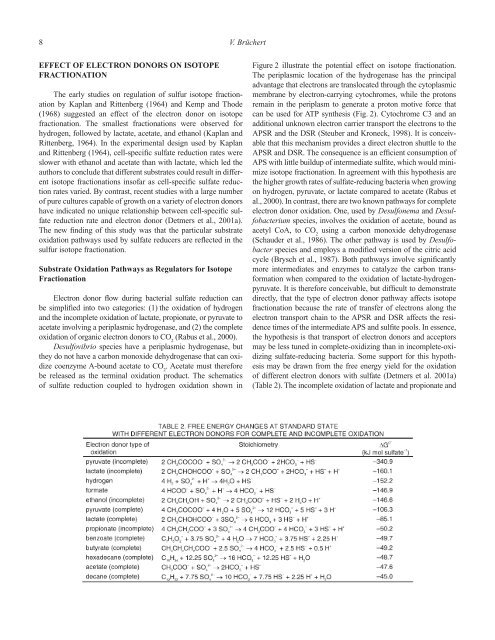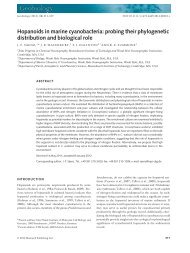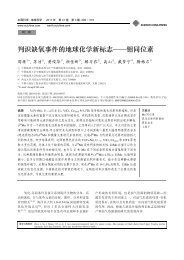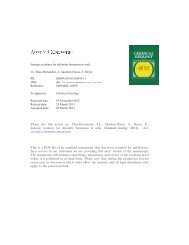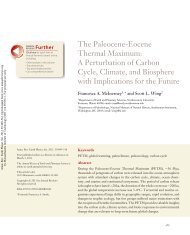Sulfur BiogeochemistryâPast and Present
Sulfur BiogeochemistryâPast and Present
Sulfur BiogeochemistryâPast and Present
- No tags were found...
You also want an ePaper? Increase the reach of your titles
YUMPU automatically turns print PDFs into web optimized ePapers that Google loves.
8 V. BrüchertEFFECT OF ELECTRON DONORS ON ISOTOPEFRACTIONATIONThe early studies on regulation of sulfur isotope fractionationby Kaplan <strong>and</strong> Rittenberg (1964) <strong>and</strong> Kemp <strong>and</strong> Thode(1968) suggested an effect of the electron donor on isotopefractionation. The smallest fractionations were observed forhydrogen, followed by lactate, acetate, <strong>and</strong> ethanol (Kaplan <strong>and</strong>Rittenberg, 1964). In the experimental design used by Kaplan<strong>and</strong> Rittenberg (1964), cell-specific sulfate reduction rates wereslower with ethanol <strong>and</strong> acetate than with lactate, which led theauthors to conclude that different substrates could result in differentisotope fractionations insofar as cell-specific sulfate reductionrates varied. By contrast, recent studies with a large numberof pure cultures capable of growth on a variety of electron donorshave indicated no unique relationship between cell-specific sulfatereduction rate <strong>and</strong> electron donor (Detmers et al., 2001a).The new finding of this study was that the particular substrateoxidation pathways used by sulfate reducers are reflected in thesulfur isotope fractionation.Substrate Oxidation Pathways as Regulators for IsotopeFractionationElectron donor flow during bacterial sulfate reduction canbe simplified into two categories: (1) the oxidation of hydrogen<strong>and</strong> the incomplete oxidation of lactate, propionate, or pyruvate toacetate involving a periplasmic hydrogenase, <strong>and</strong> (2) the completeoxidation of organic electron donors to CO 2(Rabus et al., 2000).Desulfovibrio species have a periplasmic hydrogenase, butthey do not have a carbon monoxide dehydrogenase that can oxidizecoenzyme A-bound acetate to CO 2. Acetate must thereforebe released as the terminal oxidation product. The schematicsof sulfate reduction coupled to hydrogen oxidation shown inFigure 2 illustrate the potential effect on isotope fractionation.The periplasmic location of the hydrogenase has the principaladvantage that electrons are translocated through the cytoplasmicmembrane by electron-carrying cytochromes, while the protonsremain in the periplasm to generate a proton motive force thatcan be used for ATP synthesis (Fig. 2). Cytochrome C3 <strong>and</strong> anadditional unknown electron carrier transport the electrons to theAPSR <strong>and</strong> the DSR (Steuber <strong>and</strong> Kroneck, 1998). It is conceivablethat this mechanism provides a direct electron shuttle to theAPSR <strong>and</strong> DSR. The consequence is an efficient consumption ofAPS with little buildup of intermediate sulfite, which would minimizeisotope fractionation. In agreement with this hypothesis arethe higher growth rates of sulfate-reducing bacteria when growingon hydrogen, pyruvate, or lactate compared to acetate (Rabus etal., 2000). In contrast, there are two known pathways for completeelectron donor oxidation. One, used by Desulfonema <strong>and</strong> Desulfobacteriumspecies, involves the oxidation of acetate, bound asacetyl CoA, to CO 2using a carbon monoxide dehydrogenase(Schauder et al., 1986). The other pathway is used by Desulfobacterspecies <strong>and</strong> employs a modified version of the citric acidcycle (Brysch et al., 1987). Both pathways involve significantlymore intermediates <strong>and</strong> enzymes to catalyze the carbon transformationwhen compared to the oxidation of lactate-hydrogenpyruvate.It is therefore conceivable, but difficult to demonstratedirectly, that the type of electron donor pathway affects isotopefractionation because the rate of transfer of electrons along theelectron transport chain to the APSR <strong>and</strong> DSR affects the residencetimes of the intermediate APS <strong>and</strong> sulfite pools. In essence,the hypothesis is that transport of electron donors <strong>and</strong> acceptorsmay be less tuned in complete-oxidizing than in incomplete-oxidizingsulfate-reducing bacteria. Some support for this hypothesismay be drawn from the free energy yield for the oxidationof different electron donors with sulfate (Detmers et al. 2001a)(Table 2). The incomplete oxidation of lactate <strong>and</strong> propionate <strong>and</strong>


